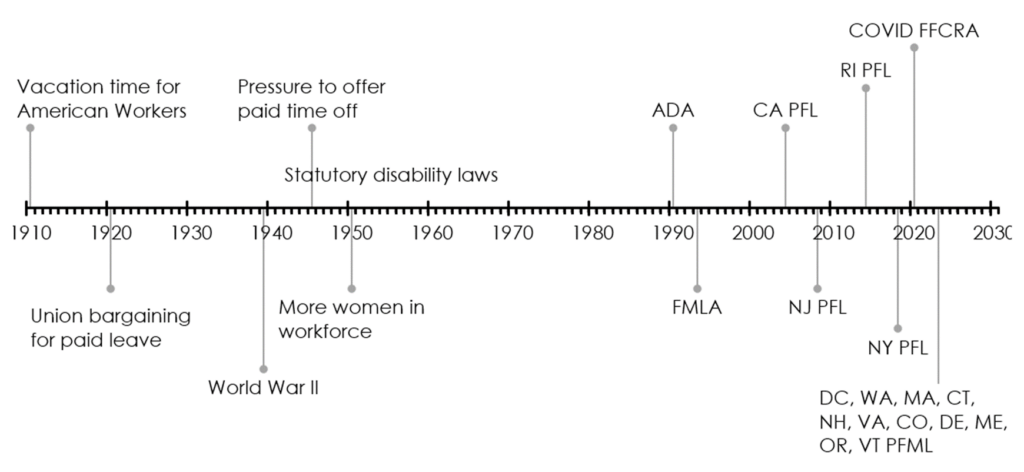While paid family and medical leave (PFML) remains in the state regulatory spotlight, much of the workforce is not covered by these laws or has leave needs outside of what is available. At the height of COVID-19, the American Journal of Emergency Medicine reported a 25%-33% increase in reported domestic violence cases. According to WHO, mental health issues rose 25% in 2020. These issues did not disappear even though the pandemic dust has settled.
Cutting-edge employers are leveraging ancillary types of paid leave as support tools for employees. They are thinking beyond traditional offerings and facilitating easier navigation so that when an employee experiences a hardship, understanding work leave options does not add to their mental burden. I had the pleasure of presenting on this topic at the 2023 Disability Management Employer Coalition (DMEC) Compliance Conference, and I wanted to share key insights.
Paid Leve Evolution
In October of 2023:
- 10 states and Washington D.C. currently require employers provide paid family and medical leave (PFML) benefits, in addition to Hawaii which requires only statutory disability benefits be provided
- 2 states have passed voluntary PFML laws with 6 more creating PFML insurance rules which allows employers to purchase insured PFML if they are interested
- 5 states are in the regulatory phase of PFML, where benefits are not yet available
- 32 states do not have PFML benefit laws (excluding Washington D.C., Hawaii which has a statutory disability benefit, and the states that fall solely into the “PFML insurance rules” category, as that does not constitute a state law)
- Still much of the workforce is not covered by these laws
- Check out our whitepaper for a more detailed landscape of state PFML policies
It has been a long road to get to this patchworked state, however. The push for time off dates back to 1910 when President Taft proposed that every American worker needed two to three months of vacation a year. U.S. legislators did not agree, so unions were left to bargain for paid vacation from the 1920s through the 1940s.
During World War II, when employers were scrambling for talent, the offer of paid vacation rose as a way to increase compensation due to wage controls that were in place at the time. Statutory paid disability laws began passing in 1942, with laws in RI, CA, NJ and NY in place by 1949.
On the federal level, very little progress was made until the mid-20th century, when women increasingly entered the workforce and thus the focus then expanded beyond paid vacation time to broader family-related leaves. From there, as illustrated below, we have seen an array of paid and unpaid leave laws pass at both the state and federal levels, with the onus for paid leave largely falling to state legislation due to a lack of movement on the federal stage.

Current Leave Landscape & Employer Tactics
Here is a high-level snapshot of leave options available today.
Mandatory
Federal
- Family and Medical Leave Act (FMLA)
- American’s Disability Act (ADA/ADAAA)
- Uniformed Services and Employment and Reemployment Rights Act (USERRA)
State
- Paid family leave (PFL)
- Paid family and medical leave (PFML)
- Statutory Disability Insurance (SDI)
- Workers’ Compensation (WC)
- Paid Sick Leave (PSL)
Local
- Sick leave laws
- Apply federal, state, and local entitlements
Voluntary
Offered at employer’s discretion
Examples Include:
- Paid leave in a state that does not offer PFL or PFML
- Personal leave
- Bereavement leave
- Vacation, sick or PTO beyond mandates
It’s important to note that of the above leaves, some are fully paid, some are partially paid, and some are unpaid. Job protection in the event of an absence from work may or may not be granted, depending on the situation and policy at play. This landscape leaves significant gaps, which many employers are looking to close with ancillary options.
Employers generally recognize the value of leave benefits, in that they serve to:
- Support employees
- Retain talent
- Recruit talent
- Combat productivity losses, often related to personal and family health problems (being “present” does not always mean being productive)
There is now a movement to expand upon traditional fundamentals in this area to better address widespread issues. Specifically, we have seen an uptick in (a sample list):
- Bereavement leave
- Domestic violence support
- Mental health support
- Personal leave
- Wellness days
- Compassionate leave
- Sabbatical leave
- Time Off in Lieu of Working Overtime (TOIL)
- Humanitarian leave
Even the most generous of programs, however, can fall short if careful thought is not given to communication strategies around offerings available, employee education surrounding leave eligibility and protocols, and population needs.
Compliance Considerations
The greater the volume of leave types on the table, the more complex compliance becomes. As such, employers should have processes in place regarding:
- Determining which leave laws and policies may apply to an employee’s request (federal, state, local) and run leaves concurrently when applicable
- Training managers involved in the employer’s leave policies
- Administering leave policies in a consistent and non-discriminatory manner
- Ensuring engaging in the interactive process to determine reasonable accommodations under the ADA which includes leave as an accommodation
- Continuing group health insurance benefits during employee leave
- Allowing for an equal amount of paid time off for parental leave policies for both caregivers
- Using language in policies that is gender neutral
- Ensuring adherence to reporting and tracking requirements
Looking Ahead
As veterans in the integrated disability and absence management space, we cannot see the future, but we can offer informed predictions about what’s to come. We anticipate state activity will continue to push employers to expand their leave offerings. Flexibility and work-life balance will remain in the spotlight, and employees will be working toward being more informed about their leave rights, so compliance will continue to take precedence. Operationally, we expect that more HR and benefits teams will turn to outsourcing to mitigate staffing issues, and will look to fully integrate leave benefits into a single system to reduce administrative burden, streamline processes, and increase reporting capabilities.
If you are interested in benchmarking your leave programs, integrating benefits, or better understanding best practices in this area, Spring would love to hear from you.


